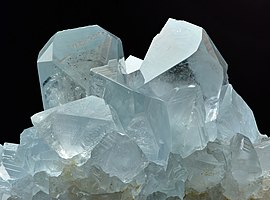| Celestine | |
|---|---|
 Clear grey-blue celestine crystals | |
| General | |
| Category | Sulfate minerals |
| Formula (repeating unit) | SrSO4 sometimes contains minor calcium and/or barium |
| IMA symbol | Clt[1] |
| Strunz classification | 7.AD.35 |
| Crystal system | Orthorhombic |
| Crystal class | Dipyramidal (mmm) H-M symbol: (2/m 2/m 2/m) |
| Space group | Pnma |
| Unit cell | a = 8.359 Å, b = 5.352 Å, c = 6.866 Å; Z = 4 |
| Identification | |
| Color | White, pink, pale green, pale brown, black, pale blue, reddish, greyish; colourless or lightly tinted in transmitted light |
| Crystal habit | Tabular to pyramidal crystals, also fibrous, lamellar, earthy, massive granular |
| Cleavage | Perfect on {001}, good on {210}, poor on {010} |
| Fracture | Uneven |
| Tenacity | Brittle |
| Mohs scale hardness | 3.0–3.5 |
| Luster | Vitreous, pearly on cleavages |
| Streak | white |
| Diaphaneity | Transparent to translucent |
| Specific gravity | 3.95–3.97 |
| Optical properties | Biaxial (+) |
| Refractive index | nα = 1.619–1.622 nβ = 1.622–1.624 nγ = 1.630–1.632 |
| Birefringence | δ = 0.011 |
| Pleochroism | Weak |
| 2V angle | Measured: 50°–51° |
| Dispersion | Moderate r < v |
| Ultraviolet fluorescence | yellow, white blue (both short and long UV) |
| References | [2][3][4][5] |
Celestine (the IMA-accepted name)[6] or celestite[1][7][a] is a mineral consisting of strontium sulfate (SrSO4). The mineral is named for its occasional delicate blue color. Celestine and the carbonate mineral strontianite are the principal sources of the element strontium, commonly used in fireworks and in various metal alloys.
- ^ a b c Warr, L.N. (2021). "IMA–CNMNC approved mineral symbols". Mineralogical Magazine. 85 (3): 291–320. Bibcode:2021MinM...85..291W. doi:10.1180/mgm.2021.43. S2CID 235729616.
- ^ "Celestine". Lexikon. Mineralien Atlas – Fossilien Atlas (in English and German). Retrieved 25 September 2022 – via mineralienatlas.de.
- ^ "Celestine" (PDF). Handbook of Mineralogy. RRUFF™ Database Project. University of Arizona Department of Geology.
- ^ "Celestine". Mindat.org.
- ^ "Celestine". Webmineral. data.
- ^ "List of Minerals". 21 March 2011.
- ^ a b Nickel, Ernie; Nichols, Monte (2004). "Mineral list / Materials data". Mineral Names, Redefinitions, & Discreditations Passed by the CNMMN of the IMA (PDF). p. 26. Archived from the original (PDF) on 30 May 2008.
Cite error: There are <ref group=lower-alpha> tags or {{efn}} templates on this page, but the references will not show without a {{reflist|group=lower-alpha}} template or {{notelist}} template (see the help page).